Elementary Sorts
COS 265 - Data Structures & Algorithms
Elementary Sorts
rules of the game
sorting problem
Ex: Student records in a university
| Chen | 3 | A | 991-878-4944 | 308 Blair |
| Rohde | 2 | A | 232-343-5555 | 343 Forbes |
| Gazsi | 4 | B | 766-093-9873 | 101 Brown |
| Furia | 1 | A | 766-093-9873 | 101 Brown |
| Kanaga | 3 | B | 898-122-9643 | 22 Brown |
| Andrews | 3 | A | 664-480-0023 | 97 Little |
| Battle | 4 | C | 874-088-1212 | 121 Whitman |
Item: a row in the table
| Furia | 1 | A | 766-093-9873 | 101 Brown |
Key: a specific entry of an item that may or may not be unique
| Furia | 1 | A | 766-093-9873 | 101 Brown |
sorting problem
Sort: Rearrange array of \(N\) items into ascending order
| Chen | 3 | A | 991-878-4944 | 308 Blair |
| Rohde | 2 | A | 232-343-5555 | 343 Forbes |
| Gazsi | 4 | B | 766-093-9873 | 101 Brown |
| Furia | 1 | A | 766-093-9873 | 101 Brown |
| Kanaga | 3 | B | 898-122-9643 | 22 Brown |
| Andrews | 3 | A | 664-480-0023 | 97 Little |
| Battle | 4 | C | 874-088-1212 | 121 Whitman |
sorting problem
Sort: Rearrange array of \(N\) items into ascending order
| Andrews | 3 | A | 664-480-0023 | 97 Little |
| Battle | 4 | C | 874-088-1212 | 121 Whitman |
| Chen | 3 | A | 991-878-4944 | 308 Blair |
| Furia | 1 | A | 766-093-9873 | 101 Brown |
| Gazsi | 4 | B | 766-093-9873 | 101 Brown |
| Kanaga | 3 | B | 898-122-9643 | 22 Brown |
| Rohde | 2 | A | 232-343-5555 | 343 Forbes |
sorting applications


sorting applications


sorting applications

sample sort client 1
Goal: Sort any type of data
Ex 1: Sort random real numbers in ascending order (seems artificial... stay tuned for an application)
public class Experiment {
public static void main(String[] args) {
int N = Integer.parseInt(args[0]);
Double[] a = new Double[N];
for(int i = 0; i < N; i++) a[i] = StdRandom.uniform();
Insertion.sort(a);
for(int i = 0; i < N; i++) StdOut.println(a[i]);
}
}
$ java Experiment 8 0.08614716385210452 0.10708746304898642 0.21166190071646818 0.363292849257276 0.460954145685913 0.5340026311350087 0.7216129793703496 0.9293994908845686
sample sort client 2
Goal: Sort any type of data
Ex 2: Sort strings in alphabetical order
public class StringSorter {
public static void main(String[] args) {
String[] a = StdIn.readAllStrings();
Insertion.sort(a);
for(int i = 0; i < a.length; i++) StdOut.println(a[i]);
}
}
$ more words3.txt bed bug dad yet zoo [...] all bad yes $ java StringSorter < words3.txt all bad bed bug dad [...] yes yet zoo [supressing newlines]
sample sort client 3
Goal: Sort any type of data
Ex 3: Sort the files in a given directory by filename
import java.io.File;
public class FileSorter {
public static void main(String[] args) {
File directory = new File(args[0]);
File[] files = directory.listFiles();
Insertion.sort(files);
for(int i = 0; i < files.length; i++)
StdOut.println(files[i].getName());
}
}
$ java FileSorter . FileSorter.class FileSorter.java Insertion.class Insertion.java Selection.class Selection.java
total order
Goal: Sort any type of data (for which sorting is well defined)
A total order is a binary relation \(\leq\) that satisfies
- Antisymmetry: if both \(v \leq w\) and \(w \leq v\), then \(v = w\)
- Transitivity: if both \(v \leq w\) and \(w \leq x\), then \(v \leq x\)
- Totality: either \(v \leq w\) or \(w \leq v\) or both
Ex:
- Standard order for natural and real numbers
- Chronological order for dates or times
- Alphabetical order for strings
No transitivity: Rock-Paper-Scissors
No totality: CSE course prerequisites
total order
Rock-Paper-Scissors violates transitivity (if both \(v \leq w\) and \(w \leq x\), then \(v \leq x\))
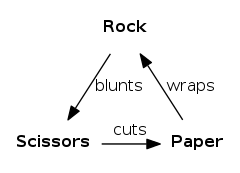
scissors \(\leq\) rock, and rock \(\leq\) paper, but scissors \(\cancel{\leq}\) paper
total order
CSE course prerequisites violate totality (either \(v \leq w\) or \(w \leq v\) or both)
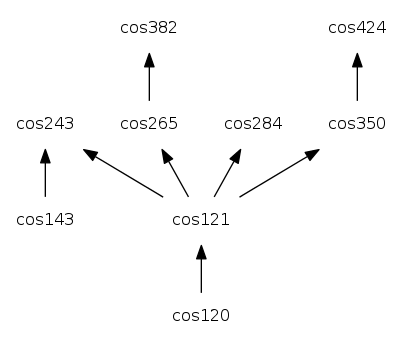
cannot compare cos382 and cos424!
callbacks
Goal: Sort any type of data (for which sorting is well defined)
Q: How can sort() know how to compare data of type Double, String, and java.io.File without any information about the type of an item's key?
Callback = Reference to executable code
- Client passes array of objects to
sort()function sort()calls object'scompareTo()method as needed
callbacks
Implementing callbacks
- Java: interfaces
- C: function pointers
- C++: class-type functors
- C#: delegates
- Python, Perl, ML, Javascript: first-class functions
callbacks: roadmap
// client code
public class StringSorter {
public static void main(String[] args) {
String[] a = StdIn.readAllStrings();
Insertion.sort(a); // <- defined below
for(int i = 0; i < a.length; i++) StdOut.println(a[i]);
}
}
// Comparable interface (built in to Java)
public interface Comparable<Item> {
public int compareTo(Item that);
}
// data-type implementation
public class String implements Comparable<String> {
/* ... */
public int compareTo(String b) {
/* ... */
return -1;
/* ... */
return +1;
/* ... */
return 0;
}
}
// sort implementation
public class Insertion {
public static void sort(Comparable[] a) {
int N = a.length;
for(int i = 0; i < N; i++)
for(int j = i; j > 0; j--)
if(a[j].compareTo(a[j-1]) < 0) exch(a, j, j-1);
// ^^^^^^^^^^^^ key point: no dependence on
// String data type!
else break;
}
}
comparable api
Implement compareTo() so that v.compareTo(w)
- defines a total order
- returns a negative integer, zero, or positive integer if
vis less than, equal to, or greater thanwrespectively - throws an exception if incompatible types (or either is
null)
if(v < w) return -1; if(v == w) return 0; if(v > w) return +1;
Built-in comparable types: Integer, Double, String, Date, File, ...
User-defined comparable types: implement the Comparable interface
implementing the Comparable interface
Date data type (simplified version of java.util.Date)
public class Date implements Comparable<Date> {
// ^^^^^
// only compares dates to other dates
private final int month, day, year;
public Date(int m, int d, int y) {
month = m;
day = d;
year = y;
}
public int compareTo(Date that) {
if(this.year < that.year ) return -1;
if(this.year > that.year ) return +1;
if(this.month < that.month) return -1;
if(this.month > that.month) return +1;
if(this.day < that.day ) return -1;
if(this.day > that.day ) return +1;
return 0;
}
}
Elementary Sorts
selection sort
selection sort demo
- In iteration
i, find indexminof smallest remaining entry - Swap
a[i]anda[min]

selection sort demo


selection sort demo


selection sort demo


selection sort demo


selection sort demo


selection sort demo


selection sort demo


selection sort demo


selection sort demo


selection sort demo


selection sort demo


selection sort demo


selection sort demo


selection sort demo


selection sort demo


selection sort demo


selection sort demo


selection sort demo


selection sort demo


selection sort demo

selection sort
Algorithm: ↑ scans from left to right
Invariants
- Entries left of ↑ (including ↑) fixed and in ascending order
- No entry to right of ↑ is smaller than any entry to the left of ↑
| X | X | X | |||||||||||||
| X | X | X | X | X | |||||||||||
| X | X | X | X | X | X | X | |||||||||
| X | X | X | X | X | X | X | X | X | X | ||||||
| X | X | X | X | X | X | X | X | X | X | X | |||||
| X | X | X | X | X | X | X | X | X | X | X | X | X | X | ||
| X | X | X | X | X | X | X | X | X | X | X | X | X | X | X | X |
| 1 | 1 | 2 | 2 | 2 | 3 | 4 | 4 | 7 | 6 | 6 | 7 | 5 | 5 | 4 | 7 |
| ↑ |
two useful sorting abstractions
Helper functions: Refer to data through compares and exchanges
Less: is item v less than w?
private static boolean less(Comparable v, Comparable w) {
return v.compareTo(w) < 0;
}
Exchange: swap item in array a[] at index i with one at index j
private static void exch(Comparable[] a, int i, int j) {
Comparable swap = a[i];
a[i] = a[j];
a[j] = swap;
}
selection sort inner loop
To maintain algorithm invariants:
- Move ↑ to the right
- Identify index of minimum entry on right
- Exchange into position
// 1
i++;
// 2
int min = i;
for(int j = i+1; i < N; j++)
if(less(a[j], a[min])) min = j;
// 3
exch(a, i, min);
selection sort: java implementation
public class Selection {
public static void sort(Comparable[] a) {
int N = a.length;
for(int i = 0; i < N; i++) {
int min = i;
for(int j = i+1; j < N; j++)
if(less(a[j], a[min])) min = j;
exch(a, i, min);
}
}
private static boolean less(Comparable v, Comparable w)
{ /* as before */ }
private static void exch(Comparable[] a, int i, int j)
{ /* as before */ }
}
selection sort: animations




Black values are sorted
Gray values are unsorted
Red triangle marks algorithm position
selection sort: mathematical analysis
Proposition: Selection sort uses \((N-1)+(N-2)+\ldots+1+0 \texttilde N^2/2\) compares and \(N\) exchanges.
Running time insensitive to input: Quadratic time, even if input is sorted
Data movement is minimal: Linear number of exchanges
Elementary Sorts
insertion sort
insertion sort demo
- In iteration
i, swapa[i]with each larger entry to its left

insertion sort demo


insertion sort demo


insertion sort demo


insertion sort demo


insertion sort demo


insertion sort demo


insertion sort demo


insertion sort demo


insertion sort demo


insertion sort demo


insertion sort demo


insertion sort demo


insertion sort demo


insertion sort demo


insertion sort demo


insertion sort demo


insertion sort demo


insertion sort demo


insertion sort demo


insertion sort demo


insertion sort demo


insertion sort demo


insertion sort demo


insertion sort demo


insertion sort demo


insertion sort demo


insertion sort demo


insertion sort demo


insertion sort demo


insertion sort demo


insertion sort demo


insertion sort demo


insertion sort demo


insertion sort demo


insertion sort demo


insertion sort demo


insertion sort demo


insertion sort demo


insertion sort demo


insertion sort demo

insertion sort
Algorithm: ↑ scans from left to right
Invariants
- Entries left of ↑ (including ↑) are in ascending order
- Entries to the right of ↑ have not yet been sorted
| X | X | ||||||||||||||
| X | X | X | X | ||||||||||||
| X | X | X | X | X | X | ||||||||||
| X | X | X | X | X | X | X | X | X | |||||||
| X | X | X | X | X | X | X | X | X | X | ||||||
| X | X | X | X | X | X | X | X | X | X | X | X | X | |||
| X | X | X | X | X | X | X | X | X | X | X | X | X | X | X | X |
| 1 | 1 | 2 | 4 | 5 | 7 | 3 | 6 | 1 | 4 | 6 | 7 | 2 | 5 | 4 | 2 |
| ↑ |
insertion sort inner loop
To maintain algorithm invariants:
- Move the pointer to the right
- Moving from right to left, exchange
a[i]with each larger entry to its left
// 1
i++;
// 2
for(int j = i; j > 0; j--)
if(less(a[j], a[j-1])) exch(a, j, j-1);
else break;
insertion sort: java implementation
public class Insertion {
public static void sort(Comparable[] a) {
int N = a.length;
for(int i = 0; i < N; i++)
for(int j = i; j > 0; j--)
if(less(a[j], a[j-1])) exch(a, j, j-1);
else break;
}
private static boolean less(Comparable v, Comparable w)
{ /* as before */ }
private static void exch(Comparable[] a, int i, int j)
{ /* as before */ }
}
insertion sort: animations

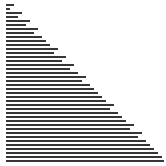

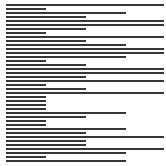
Black values are sorted
Gray values are unsorted
Red triangle marks algorithm position
insertion sort: mathematical analysis
Proposition: To sort a randomly-ordered array with distinct keys, insertion sort uses \(\texttilde \frac{1}{4}N^2\) compares and \(\texttilde \frac{1}{4} N^2\) exchanges on average.
Pf: Expect each entry to move halfway back.

insertion sort: analysis
Best case: If the array is in ascending order, insertion sort makes \(N-1\) compares and \(0\) exchanges.
A E E L M O P R S T X
Worst case: if the array is in descending order (and no duplicates), insertion sort makes \(\texttilde \frac{1}{2} N^2\) compares and \(\texttilde \frac{1}{2} N^2\) exchanges.
X T S R P O M L F E A
insertion sort: partially-sorted arrays
Def: An inversion is a pair of keys that are out of order
A E E L M O T R X P S
Above has 6 inversions: T-R, T-P, T-S, R-P, X-P, X-S
Def: An array is partially sorted if the number of inversions is \(\leq cN\)
- Ex 1: A sorted array has \(0\) inversions
- Ex 2: A subarray of size \(10\) appended to a sorted subarray of size \(N\)
Proposition: For partially-sorted arrays, insertion sort runs in linear time
Pf: Number of exchanges equals the number of inversions (num of compares = exchanges + \((N-1)\))
insertion sort: practical improvements
Half exchanges: Shift items over (instead of exchanging)
- Eliminates unnecessary data movement
- No longer uses only
less()andexch()to access data
\ /
A C H H I M N N P Q X Y K B I N A R Y
> > > > > > > ^
A C H H I K M N N P Q X Y B I N A R Y
Binary insertion sort: Use binary search to find insertion point
- Number of compares \(\texttilde N \lg N\)
- But still quadratic number of array accesses
A C H H I M N N P Q X Y K B I N A R Y
| binary search for |
first key > K
Elementary Sorts
shellsort
shellsort overview
Idea: Move entries more than one position at a time by \(h\)-sorting the array
An \(h\)-sorted array is \(h\) interleaved sorted subsequences
h = 4 full: L E E A M H L E P S O L T S X R grp0: L ----- M ----- P ----- T grp1: E ----- H ----- S ----- S grp2: E ----- L ----- O ----- X grp3: A ----- E ----- L ----- R
Shellsort [Shell 1959]: \(h\)-sort array for decreasing sequence of values of \(h\)
input: S H E L L S O R T E X A M P L E 13-sort: P H E L L S O R T E X A M S L E 4-sort: L E E A M H L E P S O L T S X R 1-sort: A E E E H L L L M O P R S S T X
\(h\)-sorting demo
- In iteration
i, swapa[i]with each larger entryhpositions to its left

\(h\)-sorting demo


\(h\)-sorting demo


\(h\)-sorting demo


\(h\)-sorting demo


\(h\)-sorting demo


\(h\)-sorting demo


\(h\)-sorting demo


\(h\)-sorting demo


\(h\)-sorting demo


\(h\)-sorting demo


\(h\)-sorting demo


\(h\)-sorting demo


\(h\)-sorting demo


\(h\)-sorting demo


\(h\)-sorting demo


\(h\)-sorting demo


\(h\)-sorting demo


\(h\)-sorting demo


\(h\)-sorting demo

\(h\)-sorted, where \(h=3\)
\(h\)-sorting
How to \(h\)-sort an array? Insertion sort, with stride length \(h\)
Why insertion sort?
- Big increments → small subarray
- Small increments → nearly in order (stay tuned!)
Shellsort example: increments 7, 3, 1
input: S O R T E X A M P L E
7-sort: S O R T E X A M P L E
M S
. P
L R
E T
M O L E E X A S P R T
3-sort: M O L E E X A S P R T
E M
E O
. X
A E M
. . S
. P X
. . . R
. . . T
A E L E O P M S X R T
1-sort: A E L E O P M S X R T
E
L
E L
O
P
M O P
S
X
R S X
T X
A E E L M O P R S T X
sorted: A E E L M O P R S T X
shellsort: java implementation
public class Shell {
public static void sort(Comparable[] a) {
int N = a.length;
int h = 1;
while(h < N/3) h = 3*h + 1; // 1, 4, 13, 40, 121, 364, ...
while(h >= 1) {
for(int i = h; i < N; i++) {
for(int j = i; j >= h && less(a[j], a[j-h]); j -= h)
exch(a, j, j-h);
}
h = h / 3;
}
}
private static boolean less(Comparable v, Comparable w)
{ /* as before */ }
private static void exch(Comparable[] a, int i, int j)
{ /* as before */ }
}
shellsort: animations



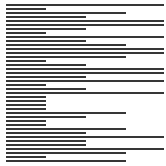
Black values are sorted
Gray values are unsorted
Dark gray values show current sub-array that is being sorted
Red triangle marks algorithm position
shellsort: which increment sequence to use?
Powers of two: 1, 2, 4, 8, 16, 32, ...
No
Powers of two minus one: 1, 3, 7, 15, 31, 63, ...
Maybe
\(3x + 1\): 1, 4, 13, 40, 121, 364, ...
OK; Easy to compute
Sedgewick: 1, 5, 19, 41, 109, 209, 505, 929, 2161, 3905, ...
(merging of \((9*4^i) - (9*2^i) + 1)\) and \(4^i - (3*2^i)+1\))
Good; tough to beat in empirical studies
shellsort: intuition
Proposition: An \(h\)-sorted array remains \(h\)-sorted after \(g\)-sorting it.
7-sort: S O R T E X A M P L E /-> 3-sort: M O L E E X A S P R T
M S | E M
. P | E O
L R | . X
E T | A E M
M O L E E X A S P R T ->/ . . S
^ ^ . P X
| | . . . R
7-sorted . . . T
A E L E O P M S X R T
^ ^
| |
still 7-sorted!
Challenge: Prove this fact—it's more subtle than you'd think!
shellsort: analysis
Proposition: The order of growth of the worst-case number of compares used by shellsort with the \(3x+1\) increments is \(N^{3/2}\).
Property: The expected number of compares to shellsort a randomly-ordered array using \(3x+1\) increment is...
| \(N\) | compares | \(2.5 N \ln N\) | \(0.25 N \ln^2 N\) | \(N^a\) |
|---|---|---|---|---|
| 5k | 93k | 106k | 91k | 64k |
| 10k | 209k | 230k | 213k | 158k |
| 20k | 467k | 495k | 290k | 390k |
| 40k | 1022k | 1059k | 1122k | 960k |
| 80k | 2266k | 2258k | 2549k | 2366k |
where \(a = 1.3\)
Remark: Accurate model has not yet been discovered (!)
why are we interested in shellsort?
Example of simple idea leading to substantial performance gains
Useful in practice
- Fast unless array size is huge (used for small subarrays, ex: R, bzip2, /linux/kernel/groups.c)
- Tiny, fixed footprint for code (used in some embedded systems, ex: uClibc)
- Hardware sort prototype
why are we interested in shellsort?
Simple algorithm, nontrivial performance, interesting questions
- Asymptotic growth rate?
- Best sequence of increments? (open problem: find a better increment sequence)
- Average-case performance?
Lesson: Some good algorithms are still waiting discovery
Elementary sorts summary
This section: Elementary sorting algorithms
Order of growth of running time to sort an array of \(N\) items
| algorithm | best | average | worst |
|---|---|---|---|
| selection sort | \(N^2\) | \(N^2\) | \(N^2\) |
| insertion sort | \(N\) | \(N^2\) | \(N^2\) |
| Shellsort (\(3x+1\)) | \(N \log N\) | ? | \(N^\threehalves\) |
| goal | \(N\) | \(N \log N\) | \(N \log N\) |
Next section: \(N \log N\) sorting algorithms (in worst case)
Elementary Sorts
shuffling
how to shuffle an array
Goal: Rearrange array so that result is a uniformly random permutation (uniformly → all permutations are equally likely)

shuffle sort
- Generate a random real number for each array entry
- Sort the array based on the generated number

shuffle sort
- Generate a random real number for each array entry
- Sort the array based on the generated number

Proposition: Shuffle sort produces a uniformly random permutation, assuming real numbers uniformly at random (and no ties)
war stary (microsoft)
Microsoft antitrust probe by EU: Microsoft agreed to provide a randomized ballot screen for users to select browser in Windows 7.

However, IE8 appeared last 50% of the time!
war stary (microsoft)
Microsoft antitrust probe by EU: Microsoft agreed to provide a randomized ballot screen for users to select browser in Windows 7.
Solution? Implement shuffle sort by making comparator always return a random answer
// browser comparator (should implement a total order!)
public int compareTo(Browser that) {
double r = Math.random();
if(r < 0.5) return -1;
if(r > 0.5) return +1;
return 0;
}
knuth shuffle demo
- In iteration
i, pick integerrbetween0andiuniformly at random - Swap
a[i]anda[r]

knuth shuffle demo


knuth shuffle demo


knuth shuffle demo


knuth shuffle demo


knuth shuffle demo


knuth shuffle demo


knuth shuffle demo


knuth shuffle demo


knuth shuffle demo


knuth shuffle demo


knuth shuffle demo


knuth shuffle demo


knuth shuffle demo


knuth shuffle demo


knuth shuffle demo


knuth shuffle demo


knuth shuffle demo


knuth shuffle demo


knuth shuffle demo

Proposition [Fisher-Yates 1938]: Knuth shuffling algorithm produces a uniformly random permutation of the input array in linear time, assuming integers uniformly at random.
knuth shuffle
- In iteration
i, pick integerrbetween0andiuniformly at random - Swap
a[i]anda[r]
Common bug: picking r between 0 and N-1.
Correct variant: between i and N-1
public class StdRandom {
/* ... */
public static void shuffle(Object[] a) {
int N = a.length;
for(int i = 0; i < N; i++) {
int r = StdRandom.uniform(i+1); // between 0 and i
exch(a, i, r);
}
}
}
Broken knuth shuffle
Q. What happens if integer is chosen between 0 and N-1?
A. Not uniformly random!
Probability of each result when shuffling A B C
| permutation | Knuth shuffle | broken shuffle |
|---|---|---|
A B C |
\(1/6\) | \(4/27\) |
A C B |
\(1/6\) | \(5/27\) |
B A C |
\(1/6\) | \(5/27\) |
B C A |
\(1/6\) | \(5/27\) |
C A B |
\(1/6\) | \(4/27\) |
C B A |
\(1/6\) | \(4/27\) |
War story (online poker)
Texas hold'em poker: Software must shuffle electronic cards

War story (online poker)
// shuffling algorithm in FAQ at www.planetpoker.com
for i := 1 to 52 do begin
r := random(51) + 1; // between 1 and 51
swap := card[r];
card[r] := card[i];
card[i] := swap;
end;
Bug 1: Random number r never 52 ⇒ 52nd card cannot end up in 52nd place
Bug 2: Shuffle not uniform (should be between 1 and i)
Bug 3: random() uses 32-bit seed ⇒ \(2^{32}\) possible shuffles
Bug 4: Seed = milliseconds since midnight ⇒ 86.4 million shuffles
War story (online poker)
“The generation of random numbers is too important to be left to chance.
”
—Robert R. Coveyou
War story (online poker)
Best practices for shuffling (if your business depends on it)
- Use a hardware random-number generator that has passed both the FIPS 140-2 and the NIST statistical test suites
- Continuously monitor statistic properties: hardware random-number generators are fragile and fail silently
- Use an unbiased shuffling algorithm



Bottom line: Shuffling a deck of cards is hard!
